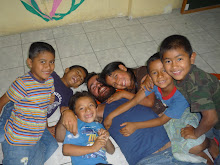Google map for Sierra Nevada (the Lost City, the archeology site which is the topic of this post, is somewhere close to that!):
http://maps.google.com/maps?f=q&source=s_q&hl=es&geocode=&q=sierra+nevada+colombia&sll=10.744271,-73.979187&sspn=1.284428,2.801514&ie=UTF8&ll=10.927708,-74.187927&spn=1.283641,2.801514&z=9&iwloc=A
This was a 5-day (more like 4 days, or 96 hours, to be more accurate!) hike through the stunning scenery of Sierra Nevada, a mountainous system in the north of Colombia that goes as high as 5800m. We didn’t go that high (only from sea level up to 1500m, I think) as the area surrounding the peaks is not yet completely safe for travel…
On this hike you go through really steep hills, but the fact you only walk for 4 or 5 hours a day makes it quite OK. Not exactly a walk in the park, but quite doable. You cross the lands of the Tayronas, who ruled Ciudad Perdida and its surroundings until the Spanish conquest.
You also cross what used to be a major cocaine cultivation area. Since the early 2000s, when the government launched a strong campaign against drug production and smuggling in the region (in the hands of both guerrilla and paramilitary groups), massive cocaine production has moved almost exclusively to further west and south in the country. But you can still see traces of that past. Be it the small farmer who still produces “just one kilo or so once in a while", and insists on tell you all about it. Or be it the common police and military roadblocks in the coast, with passengers having to step out of the bus for it to be inspected and searched. Even if cocaine may not be produced large scale around here anymore, the Caribbean coast is still a major gateway for it to be shipped further north, so…
But well, back to Ciudad Perdida: the hike offers amazing landscapes, ranging from green mountains as far as your eyes can reach, to idyllic rivers that you have to cross over and over again.
The group was quite small – two of us plus the guide – which means you could go at a fairly good and steady pace. A mule helps carrying most of the supplies during the first 2 days, and from then onwards you and the guide (more the guide, actually…) walk with the food you need uphill.
After so many centuries, there are no traces of the wooden houses where the Tayronas inhabited, of course. But the stone stairways and platforms where they built their houses and ceremonial buildings are still in impressive good shape.
The city spreads surprisingly wide, and it’s hard to imagine more beautiful “suburbs” than the tropical landscape, lush and green, that surrounds it.
It’s sad to see what’s left of this indigenous people. Even if the Spanish never conquered Ciudad Perdida, they kept pushing the Tayronas further up their territory, far away from the network of cities and villages that were once connected by stone roads built deep in the jungle. Apparently it were the gold artefacts possessed by the Tayronas that created the El Dorado myth, and we all know what happened from there, don’t we? Portuguese and Spanish – what a legacy in Latin America…
Since you cross Tayrona territory to reach Ciudad Perdida, the hiking agencies pay them a fee for every tourist they bring uphill. But it’s clear these people live with very little, and it’s not nice to see them so dependent on tourism – they’re often hired to help bring supplies up the mountain, and entire families drop by the mountain refuges, set up by the agencies to accommodate the tourists, in search of a bit of food at dinner time. Not to mention the groups of children that wait all day doing nothing, until a group of hikers passes by and they finally can sell some fruit for a few dollars.
But well, tourism is not so bad sometimes. It seems like it’s a driving force of a relative peace in the region – since foreigner visitors started coming to the Caribbean region in larger numbers, rebels, paramilitaries and drug dealers have been kept more or less at bay. It’s hard to say what came first, the egg or the chicken – i.e., whether the tourists came first and the situation improved next or vice-versa – but it seems beyond question amongst the locals that the presence of tourists in the region helps make live safer for everyone.
Happy to know that.
The man and the challenge, staring at it


 The man and the challenge, taking it
The man and the challenge, taking it Tania, one of the neighbours during our first night. The first night was spent in a small village; the following nights in small mountain refuges owned by the trekking agency. By the way, I thought I could sleep easily pretty much everywhere, but consecutive nights on a hammock made me question that belief…
Tania, one of the neighbours during our first night. The first night was spent in a small village; the following nights in small mountain refuges owned by the trekking agency. By the way, I thought I could sleep easily pretty much everywhere, but consecutive nights on a hammock made me question that belief…The best and most famous view of Ciudad Perdida: this was the ceremonial centre of the place. Apparently it was the site for one of the Indiana Jones movies, but I can’t figure out which one. Can you?











No comments:
Post a Comment